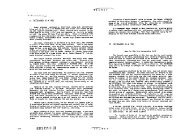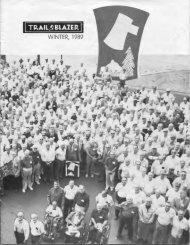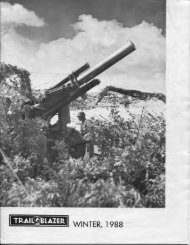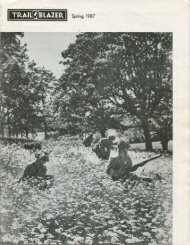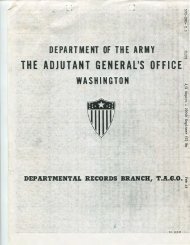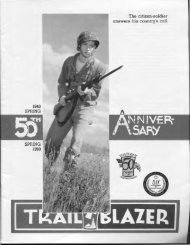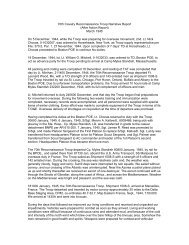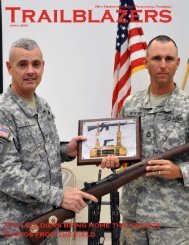Download - 70th Infantry Division Association
Download - 70th Infantry Division Association
Download - 70th Infantry Division Association
You also want an ePaper? Increase the reach of your titles
YUMPU automatically turns print PDFs into web optimized ePapers that Google loves.
and then at night filing back and picking up another one and using it, knowing the guy who had used it<br />
before had stomped mud all over it, may have bled on it, or even gotten sick on it. It didn't matter, that<br />
was your bed for the night, and when you were finished with it, you rolled it back up and threw it in the<br />
trailer. The next night you got another man's bed roll again, never the same one.<br />
While at Myles Standish, we had wood fires in the barracks and we pulled guard duty seven days a week,<br />
24 hours a day, right around the clock, so that we could watch the fires to make sure the temperature<br />
stayed warm in the barracks, also so as not to burn the barracks down.<br />
Mostly what we were doing at Camp Myles Standish was training. We were issued books to read in<br />
German and weapons which we learned to clean. We had a fellow non-commissioned officer by the name<br />
of Gibson; we called him "Hoot" Gibson. Hoot made a bet with all the people in his particular building that<br />
he could detail strip his 45, carbine and M1 rifle, put all the pieces in the bed and then, blindfolded, put it<br />
all back together in four hours. We had nothing else to do so we bet old Hoot that he couldn't do it. So he<br />
sat down on his bunk with his 45, his carbine, his Ml, and detail stripped it all, took out the springs, the<br />
hair pins, all details cut. At the conclusion of the four hours, Hoot had assembled all the weapons and<br />
collected about $1,000 for four hours work. This was really unique since all the pieces in these weapon<br />
had to fit the individual weapon. If I remember right, the 45 had 48 parts.<br />
On 5 December 1944 an advance party moved to Boston. Massachusetts, by rail and boarded the<br />
transport to prepare for the arrival of the troops on the following day. The regiment moved by rail the<br />
morning of 6 December 1944 to Boston and immediately boarded ship. At 1630 on 6 December 1944 the<br />
transport lifted anchor and stood out from Boston harbor for the Atlantic passage. Training enroute<br />
included orientation, abandon ship drill and care and cleaning of equipment. The regiment was<br />
transported to Marseille, France, arriving in that port the morning of 15 December 1944. Immediately after<br />
noon unloading began, the troops being taken off on barges and set ashore at Callahan Beach. As they<br />
arrived, they were transported by truck to Delta Base CP No. 2, where a bivouac was established, the<br />
troops pitching pup tents in company-street formation.<br />
During the week of CP No. 2, the regiment was issued complete motorized equipment, 57-mm AT guns,<br />
105-mm cannons and was brought up to T/E strength in all respects.<br />
On December 6, 1944. we boarded a train from Camp Myles Standish which took us to Boston, the Port<br />
of Entry. They backed the train right down alongside the ship, The USS West Point, which was<br />
commissioned from the USS America, the biggest American ship in American lines that America had at<br />
that time. As we got off the train in units, we marched down to the gangplank and it was kind of sad the<br />
way we were in a state of mass confusion while a band was playing "Oh, Suzanna". As we started up the<br />
gangplank, we had to call off our serial number, name and rank. The First Sergeant had a roster and he<br />
made sure that every man aboard the ship was accounted for. One hundred ninety men and six officers<br />
stomped up that old gangplank under Captain James R. Michael, a West Point graduate. We sailed at<br />
1600 on December 6, 1944, for foreign duty. We had no idea where we were going, other than we figured<br />
we were headed for Europe.<br />
On December 7, 1944, which is Pearl Harbor Day, we were on the sea to foreign duty. The trip itself, from<br />
December 6 to December 16, was basically uneventful. We crossed the Atlantic Ocean by the route from<br />
Boston, moving along the coast of Miami, and going straight across to the Mediterranean Sea, passing by<br />
the Rock of Gibraltar. The first two days at sea a U.S. Navy blimp followed us. We changed course every<br />
so many minutes so that the submarines could not get a fix on us. When the dirigible returned to the U.S.,<br />
after two days at sea, a 4-motor bomber escorted us. Criss-crossing our path, he would be there for 15<br />
seconds and then he would be gone, then back again and gone, until finally, at the end of our trip, on<br />
about the 9th day, we had nobody, and of course we were approaching enemy waters at that particular<br />
time.<br />
We arrived in Marseilles, France, at Delta Base Section Command Post No. 2. I'll never forget how they<br />
brought landing crafts out and we went over the side, and down into the landing crafts, and we came



